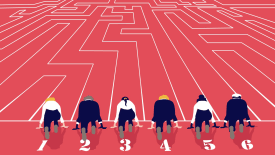You have 1 article left to read this month before you need to register a free LeadDev.com account.
Estimated reading time: 4 minutes
“Empowerment” has entered buzzword territory.
Every day, sales pitches in my LinkedIn inbox remind me of this:
- “We empower sales professionals to close more leads.”
- “Our software is an empowerment platform for online sellers.”
- “This tool empowers users to find dogs to walk on their nights and weekends.”
That’s because empowerment is a compelling concept. It means a given tool or process allows you to do more with less, have outsized impact even with downsized oversight, and eliminate the boring stuff in favor of the meaningful stuff. Empowerment is still a useful concept, but its meaning has been marred by empty sales pitches and lazy website copy.
Data is the best way to truly empower engineers. Its most important function is helping individual contributors measure their impact, and turn that into real business outcomes.
How data empowers engineers
Data allows engineers to make their own goals, and engineering teams to make their own decisions, all of which contribute to a larger organizational vision. Equipped with real insights, they can move beyond gut feelings and make informed decisions.
Thinking like a video game, access to good data can power up an engineer to make more impact on the stuff that really matters.
How can you increase your power level?
Power level 1: Basic analytics
Data starts with visibility – understanding product usage at a high level. Engineers can see how users interact with different features, how long they stay engaged, and whether their behavior matches expectations. This visibility is critical because it reveals patterns and behaviors that might otherwise go unnoticed.
One of the best places to start is with key acquisition funnels for your product. The sign up funnel, the purchase funnel, you name it, every product has an important sequence to optimize. Looking at a funnel allows teams to pinpoint drop-off points in user journeys. And by understanding where users leave, they can optimize those pain points, increasing conversion rates or user retention.
A purchase funnel
Additionally, teams can see the impact of their engineering efforts, and adjust accordingly. If they deploy a new feature or redesign part of the app, analytics will reveal whether it leads to higher user engagement, revenue, or whatever metrics matter most to the company.
Power level 2: Feature flagging for controlled rollouts
Feature flagging is an engineering practice, and a compelling software tool, but at its core it’s the result of weaving engineering and data-driven decision-making together.
Feature flags allow for controlled rollouts of features, which is essential because not every feature will be successful. Anecdotally, two out of every three features might not deliver the intended impact.
We like to think that everything we work on is an improvement, but the reality is much different.
With feature flagging, teams have the flexibility to roll out a feature to a small percentage of users, monitor its performance, and, if needed, roll it back, all without disrupting the entire user base.
This controlled iteration cycle empowers teams to test more frequently, fail faster, and course-correct with minimal risk. The impact of individual features being launched behind feature flags compounds, helping to laser-focus engineering efforts towards larger, shared goals.
Data from controlled rollouts informs whether a feature is worth scaling, needs some adjustments, or deserves to be shut down. If you were able to identify and iterate on or disable the 2/3rds of features that actually have a neutral or negative impact, this is what your metric growth can look like.
I’ve seen this effect firsthand. Meta, for example, is notorious for its data-driven culture, which starts with aggressive goal setting. When engineers are all aligned and moving towards the same goals, it helps takes the emotion out of decisions to kill underperforming features, iterate on others, and double down on the best performing ones.
Power level 3: Experimentation
At the highest level, data empowers engineers through experimentation.
Experimentation allows teams to move beyond basic assumptions or intuition and into data-backed decisions. By running controlled experiments, teams can validate hypotheses, test new features, and optimize existing ones with precision.
For example, an engineer might hypothesize that changing the layout of a key feature will improve engagement. Rather than guessing, they can test this change with a subset of users and gather statistically significant results.
☝️ This graph is from our Rec Room case study. Note the negative effects of the V1 changes, and how they used data to turn the trend around. In short, this experiment was redesigning the main user profile page. The new design “looked” better, but it became clear that it was harder for users to find the “message” button to message their friends. As such, the number of chat threads created cratered with the new version.
After seeing that in the experiment results, they were able to iterate and try a new version, which was better but still regressed this key metric. It took one last iteration to turn it into a positive change.
Experimentation not only accelerates all the insights that lead to better engineering decisions, but also ensures that decisions are grounded in evidence.
Teams with an experimentation culture systematically optimize their product, learning from each experiment to build better features, improve user experience, and drive results.
Use your data!
If you’re looking to scale your own career, your team, or the whole company, you need to be aligned on key metrics. You’ll notice the outcomes almost immediately, and start to identify and invest in areas of your product you might not have thought to spend time on in the first place.
Promoted Partner Content






